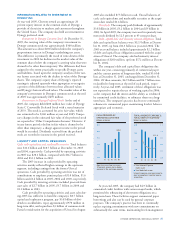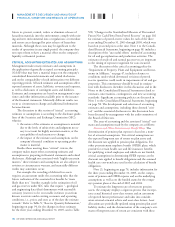Chevron 2005 Annual Report Download - page 47
Download and view the complete annual report
Please find page 47 of the 2005 Chevron annual report below. You can navigate through the pages in the report by either clicking on the pages listed below, or by using the keyword search tool below to find specific information within the annual report.CHEVRON CORPORATION 2005 ANNUAL REPORT 45
mance by the counterparty. Both parties settle each side of
the buy/sell through separate invoicing.
The company routinely enters into buy/sell contracts,
primarily in the United States downstream business, asso-
ciated with crude oil and refi ned products. For crude oil,
these contracts are used to facilitate the company’s crude
oil marketing activity, which includes the purchase and sale
of crude oil production, fulfi llment of the company’s sup-
ply arrangements as to physical delivery location and crude
oil specifi cations, and purchase of crude oil to supply the
company’s refi ning system. For refi ned products, buy/sell
arrangements are used to help fulfi ll the company’s supply
agreements to customer locations and specifi cations.
The company has historically accounted for buy/sell
transactions in the Consolidated Statement of Income the
same as for a monetary transaction – purchases are reported
as “Purchased crude oil and products;” sales are reported as
“Sales and other operating revenues.” The SEC raised the
issue as to whether the accounting for buy/sell contracts
should be shown net on the income statement and accounted
for under the provisions of Accounting Principles Board
(APB) Opinion No. 29, “Accounting for Nonmonetary Trans-
actions” (APB 29). The company understands that others in
the oil and gas industry may report buy/sell transactions on a
net basis in the income statement rather than gross.
The Emerging Issues Task Force (EITF) of the FASB
deliberated this topic as Issue No. 04-13, “Accounting for
Purchases and Sales of Inventory with the Same Counterparty”
(EITF 04-13). At its September 2005 meeting, the EITF
reached consensus that two or more legally separate exchange
transactions with the same counterparty, including buy/sell
transactions, should be combined and considered as a single
arrangement for purposes of applying APB 29 when the
transactions were entered into “in contemplation” of one
another. EITF 04-13 was ratifi ed by the FASB in September
2005 and is effective for new arrangements, or modifi cations
or renewals of existing arrangements, entered into beginning
on or after April 1, 2006, which will be the effective date for
the company’s adoption of this standard. Upon adoption, the
company will report the net effect of buy/sell transactions on
its Consolidated Statement of Income as “Purchased crude
oil and products” instead of reporting the revenues associated
with these arrangements as “Sales and other operating rev-
enues” and the costs as “Purchased crude oil and products.”
While this issue was under deliberation by the EITF, the
SEC staff directed Chevron and other companies to disclose
on the face of the income statement the amounts associated
with buy/sell contracts and to discuss in a footnote to the
fi nancial statements the basis for the underlying accounting.
The amounts for buy/sell contracts shown on the company’s
Consolidated Statement of Income “Sales and other operating
revenues” for the three years ending December 31, 2005, were
$23,822, $18,650 and $14,246, respectively. These revenue
amounts associated with buy/sell contracts represented 12
percent of total “Sales and other operating revenues” in 2005,
2004 and 2003. Nearly all of these revenue amounts in each
period associated with buy/sell contracts pertain to the com-
pany’s downstream segment. The costs associated with these
buy/sell revenue amounts are included in “Purchased crude
oil and products” on the Consolidated Statement of Income
in each period.
Other Contingencies Chevron receives claims from, and
submits claims to, customers, trading partners, U.S. federal,
state and local regulatory bodies, host governments, contrac-
tors, insurers and suppliers. The amounts of these claims,
individually and in the aggregate, may be signifi cant and
may take lengthy periods to resolve.
The company and its affi liates also continue to review
and analyze their operations and may close, abandon, sell,
exchange, acquire or restructure assets to achieve operational
or strategic benefi ts and to improve competitiveness and prof-
itability. These activities, individually or together, may result
in gains or losses in future periods.
ENVIRONMENTAL MATTERS
Virtually all aspects of the businesses in which the company
engages are subject to various federal, state and local envi-
ronmental, health and safety laws and regulations. These
regulatory requirements continue to increase in both number
and complexity over time and govern not only the manner
in which the company conducts its operations, but also the
products it sells. Most of the costs of complying with laws
and regulations pertaining to company operations and prod-
ucts are embedded in the normal costs of doing business.
Accidental leaks and spills requiring cleanup may occur
in the ordinary course of business. In addition to the costs
for environmental protection associated with its ongoing
operations and products, the company may incur expenses
for corrective actions at various owned and previously owned
facilities and at third-party-owned waste-disposal sites used
by the company. An obligation may arise when operations are
closed or sold or at non-Chevron sites where company products
have been handled or disposed of. Most of the expenditures to
fulfi ll these obligations relate to facilities and sites where past
operations followed practices and procedures that were con-
sidered acceptable at the time but now require investigative or
remedial work or both to meet current standards.
Using defi nitions and guidelines established by the
American Petroleum Institute, Chevron estimated its world-
wide environmental spending in 2005 at approximately $1.3
billion for its consolidated companies. Included in these
expenditures were $341 million of environmental capital
expenditures and $979 million of costs associated with the
prevention, control, abatement or elimination of hazardous
substances and pollutants from operating, closed or divested
sites, and the abandonment and restoration of sites, which
includes $14 million and $66 million, respectively, for
Unocal activities for the last fi ve months of 2005.
For 2006, total worldwide environmental capital expen-
ditures are estimated at $1.1 billion. These capital costs are
in addition to the ongoing costs of complying with envi-
ronmental regulations and the costs to remediate previously
contaminated sites.
It is not possible to predict with certainty the amount
of additional investments in new or existing facilities or
amounts of incremental operating costs to be incurred in the
























